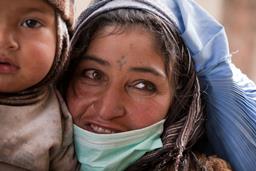 Kabul 31 July 2016 – The Ministry of Public Health and WHO marked the World Hepatitis Day in Kabul today to increase awareness of the burden of viral hepatitis, its causes, symptoms and treatment. Viral hepatitis – a group of infectious diseases known as hepatitis A, B, C, D, and E – causes acute and chronic liver disease and kills around 1.4 million people around the world every year, more than tuberculosis or malaria. Only 1 in 20 people with viral hepatitis know they have it, making hepatitis a dangerous and silent killer.
Kabul 31 July 2016 – The Ministry of Public Health and WHO marked the World Hepatitis Day in Kabul today to increase awareness of the burden of viral hepatitis, its causes, symptoms and treatment. Viral hepatitis – a group of infectious diseases known as hepatitis A, B, C, D, and E – causes acute and chronic liver disease and kills around 1.4 million people around the world every year, more than tuberculosis or malaria. Only 1 in 20 people with viral hepatitis know they have it, making hepatitis a dangerous and silent killer.
In Afghanistan 1804 hepatitis cases were diagnosed and reported in 2015 – 1343 hepatitis B and 461 hepatitis C cases. However, the burden of the disease is likely to be significantly higher.
“We must accelerate our efforts to make sure that not a single Afghan dies of hepatitis which is preventable and treatable,” said Dr Najia Tariq, Deputy Minister of Public Health of Afghanistan. “The Ministry of Public Health is stepping up efforts to ensure better access to services and medicines to all Afghans in need. I encourage people to take up free vaccination and testing services in health facilities throughout the country to increase diagnosis and to learn about hepatitis prevention.”
There is now a treatment available that can cure hepatitis C and over 90% of people with hepatitis C can be completely cured of the virus within 3–6 months. Awareness, testing and screening is key to fighting the virus.
“Any death because of hepatitis is one death too many. Viral hepatitis is a major public health problem that has for too long remained unknown or ignored,” says Dr Richard Peeperkorn, WHO WHO Representative in Afghanistan. “We need to eliminate this silent killer. WHO is supporting the Ministry of Public Health in increasing access to screening and treatment, widening vaccination coverage, raising public awareness and stepping up prevention efforts.”
Hepatitis viruses are transmitted through different routes: hepatitis A and E through contaminated food and water; hepatitis B through blood and other bodily fluids, and hepatitis C mostly through blood. These viruses all cause acute hepatitis which is characterized by fatigue, loss of appetite, fever and jaundice (yellowing of the skin and the whites of the eyes). Hepatitis infection can be prevented by providing safe food and water (hepatitis A and E), vaccines (hepatitis A, B, and E), screening of blood donations and provision of sterile injecting equipment and assuring infection control (hepatitis B and C).
2016 is a pivotal year for viral hepatitis. At the World Health Assembly in May, 194 governments, including Afghanistan, adopted the first-ever Elimination Strategy for viral hepatitis and agreed to the first-ever global targets. The strategy includes a target to treat 8 million people for hepatitis B or C by 2020. The longer term aim is to reduce new viral hepatitis infections by 90% and to reduce the number of deaths due to viral hepatitis by 65% by 2030 from 2016 figures.


